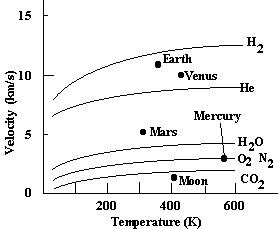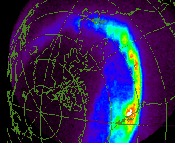For the terrestrial planets, N2, Carbon Dioxide and Water are the main constituents. (Earth's oxygen is a biological pollutant and not naturally occurring). Venus, Earth and Mars all have atmospheres made up of one or more of these species. But Mercury and the Moon are TOO SMALL and TOO HOT.
 Escape Velocity
Escape Velocity
If a rocket or projectile is fired off with a velocity greater than 11.2
km/sec (25,000 miles per hour) from Earth's surface, it will
escape Earth altogether.
Note in the figure, the more massive and dense a planet, the
greater the escape velocity (higher in the graph). The Moon and
Mercury are small planets, and the Moon in particular has a very
low density.
Temperature
Hydrogen and helium are the lightest atoms.
Carbon Dioxide, Water, and N2 are
more heavy molecules. At a single
temperature, the massive molecules move slowest and
the light atoms move faster. The hotter the gas, the
faster the atoms move. If a planet's atmosphere is hot
enough, the lightest atoms in the atmosphere may move fast
enough to achieve the escape velocity evaporate
away entirely from the planet! The temperature of
the planets directly correlates
with distance from the Sun.
Evolution of Mars' Atmosphere
Early on, the terrestrial planets lost their
hydrogen gas (H2) in their atmosphere. Mars is
massive enough to keep its water, N2 and
carbon dioxide. However, UV light from the Sun broke up
the water molecules, releasing the light hydrogen atoms to
space (this happened on Venus, too). The oxygen left over
stuck around and reacted with the rock, rusting the
Martian surface, giving it its distinctive orange color.
Because of the large fraction of heavy elements still
captured by Mars (Argon, etc), it is believed Mars once had a
more dense atmosphere.
 The Effect of the Solar Wind
The Effect of the Solar Wind
Particles (mostly protons and electrons) come streaming from the
Sun all the time. They do not penetrate Earth's atmosphere
because we have a magnetic field, which acts like a shield to
charged particles (they can not cross the field lines easily!).
 When a large Solar storm releases a large burst of particles,
it's seen as an Aurora Borealis on Earth, such as seen
early this week, as the charged
particles spiral down on the Earth's magnetic pole. On Mars,
however, there is no magnetic field! Charged particles come
streaming through at enormous velocity and help to strip away
molecules in Mars' atmosphere.
When a large Solar storm releases a large burst of particles,
it's seen as an Aurora Borealis on Earth, such as seen
early this week, as the charged
particles spiral down on the Earth's magnetic pole. On Mars,
however, there is no magnetic field! Charged particles come
streaming through at enormous velocity and help to strip away
molecules in Mars' atmosphere.